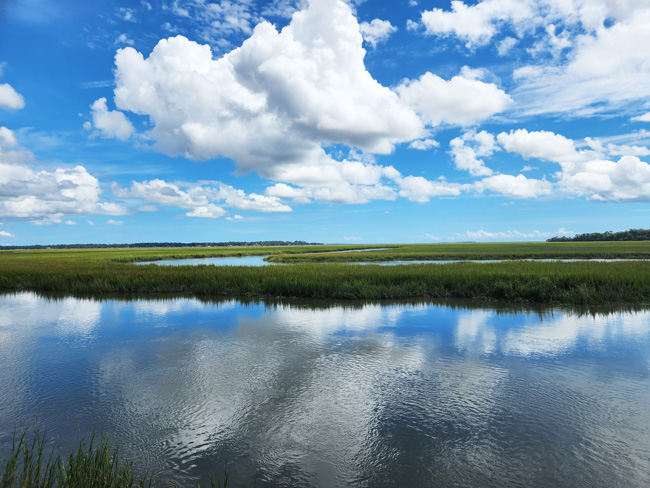A race between rising sea levels and sediment discharge from coastal rivers may determine the future health of salt marshes in Georgia and South Carolina, and it appears that rising sea levels are winning. That is the conclusion of a paper by University of Georgia Skidaway Institute of Oceanography researcher Herb Windom and published in the Journal of Coastal Research.
Salt marshes are a key part of the coastal ecosystem, fulfilling several important biological and geological functions. These include serving as a breeding ground and nursery for many species of marine life and functioning as a protective barrier from storms. Salt marshes thrive only in the intertidal zone, where they are submerged by salt water for just a portion of the tidal cycle. If submerged completely, the salt marsh vegetation will die.

Salt marshes like this one in Chatham County are endangered by rising sea levels
Sea levels have been rising over the past several decades at a rate of approximately 3.3 millimeters per year or about a foot per century. Salt marshes have been able to stay ahead of the rising sea level by adding sediment carried to the marsh and deposited there by river discharge. Windom and fellow researcher Jonathan Palmer looked at the historic record of sediment discharge collected by the U.S. Geological Survey and discovered the mass of sediment discharge is not sufficient to grow the marsh faster than sea level will rise.

Herb Windom
“Sea levels will rise up to the point that the salt marshes cannot be sustained unless they have sediment coming up to support the salt marshes,” Windom said. “We did a budget on how much sediment was coming down into the salt marshes and how sustainable were the salt marshes. It turns out the available sediment is only about two-thirds of what is needed to keep up with sea level rise.”
Human activity—specifically the construction of dams and reservoirs on the rivers—has trapped sediment and prevented it from being carried downstream to enrich salt marshes. Dams and reservoirs have shrunk the amount of sediment discharge by approximately 2% per decade.
Windom and Palmer concentrated their study on the Georgia Bight, a stretch of the Atlantic coast from Cape Romain, S.C., to Cape Canaveral, Fla. The area encompasses 750,000 acres (approximately 3,000 square kilometers) of salt marsh, enriched by a number of piedmont and coastal plain river systems. They found those rivers delivered approximately 10 million metric tons of sediment annually, or approximately 100 milligrams per square centimeter of marsh. This falls significantly short (only about 67%) of the approximately 148 milligrams per square centimeter required to maintain a 3.3 millimeter annual growth and keep up with sea level rise.
Salt marshes can also survive by migrating to higher ground as sea level rises. However, recent trends of armoring shorelines with sea walls and other structures to protect buildings and property prevents such migration in many areas.
Ironically, while the current issue with salt marshes is the result of human activity – building dams and reservoirs mostly on Piedmont rivers — it was also human activity hundreds of years ago that created the vast marshes that exist today.
“All of the marshes along the east coast of North America, and probably the Gulf Coast as well, are relics of European colonization and row crop agriculture,” Windom said. “That released a lot of soil and transported it to the coast, but now it is being trapped by all the reservoirs and it’s not getting here.”
The reduction of sediment discharge into the saltmarshes is made worse by yet another human activity: dredging. Typically, the dredge spoil is placed in impoundments and sequestered from the surrounding ecosystem. This removes more of the sediment that makes it past the reservoirs from being used by saltmarshes.
The good news, according to Windom, is the process will not happen quickly. Currently, salt marshes are losing the race by about a millimeter per year. If sea levels continue to rise at the current rate, it may be decades before the marshes are seriously affected.
The entire paper can be accessed at https://doi.org/10.2112/JCOASTRES-D-21-00119.1.


